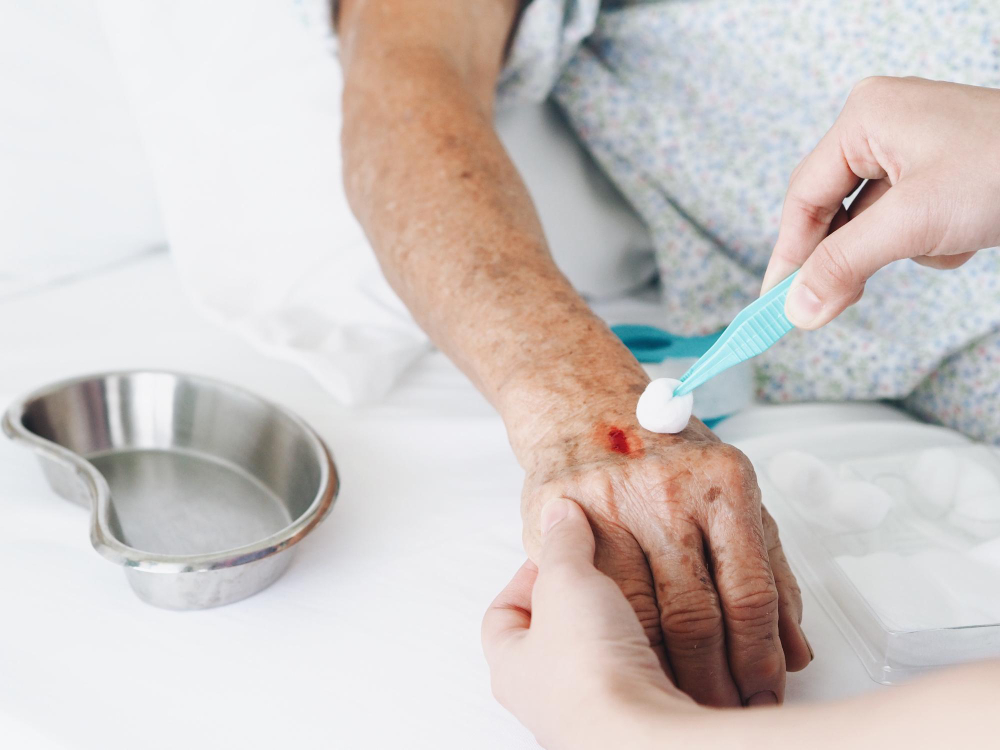Wound Swelling is one of the body’s natural responses to injury. It’s caused by fluid and white blood cells rushing to the wound area to fight infection and start the healing process. While some swelling is expected, excessive swelling can slow down recovery or lead to complications.
In a busy city like Chicago, where people often walk or work long hours, swelling around wounds can worsen due to movement, pressure, or heat. That’s why knowing how to reduce swelling fast is essential.
Step 1: Clean the Wound Properly
Start by gently cleaning the wound to remove any dirt or debris. This helps prevent infection, which is a significant cause of increased swelling.
For signs of severe infection, such as pus or warmth, check
Signs of Infection After Stepping on a Nail
Step 2: Apply Cold Compress
Use a clean cloth with cold water or ice (wrapped) and press gently over the swollen area. Do this in 10-minute intervals with breaks in between.
This technique slows blood flow to the area, helping to reduce fluid buildup. For those recovering from
Wound Stitches are especially helpful during the first 48 hours.
Step 3: Elevate the Wound Area
If your wound is on the hand, arm, foot, or leg, try to keep it elevated above heart level. It allows fluids to drain and swelling to go down naturally.
You can also review
How to Care for Wound Stitches for more recovery tips.
Step 4: Avoid Excess Movement
Moving too much too early can cause the wound to reopen or the swelling to worsen. In Chicago’s active lifestyle, this is often overlooked. Whether you’re commuting or working on your feet, keep the injured area supported and still whenever possible.
If you’re unsure how severe the injury is, this guide can help:
How Can You Assess the Severity of a Deep Puncture Wound
Step 5: Monitor for Complications
Some swelling is normal, but persistent or painful swelling may signal infection. If you experience fever, increased redness, or pus, it’s time to seek urgent care.
You can read
What Makes Same-Day Medical Attention Essential? To understand why acting fast matters.
Keep the Wound Area Clean and Dry
One of the simplest yet most important ways to reduce swelling is to keep the wound clean and dry at all times.
When dirt, sweat, or moisture enters an open wound, it can trap bacteria and slow down the healing process—often leading to increased swelling or even infection.
Cleaning the area with mild soap and lukewarm water once a day is usually enough. After washing, gently pat the wound dry with a clean towel and apply a sterile bandage if needed.
Avoid using alcohol or harsh antiseptics, as these can irritate the tissue and delay recovery. A clean wound heals faster, swells less, and is far less likely to become infected.

Key tips:
- Use lukewarm water, not hot
- Avoid scrubbing or rubbing the wound
- Pat dry gently with a soft towel
Use Proper Wound Dressings
Using the proper wound dressing plays a significant role in reducing swelling and preventing infection. A clean, breathable dressing keeps out bacteria while allowing the skin to heal naturally. It also protects the wound from friction or pressure that could cause irritation and further inflammation.
Always choose non-stick, sterile bandages that don’t trap moisture against the skin. Change the dressing regularly—ideally once a day or sooner if it becomes wet or dirty.
Avoid using tight or air-blocking materials, as they can trap heat and worsen swelling. With the proper dressing, you help your body stay protected while it heals efficiently.
Important reminders:
- Replace dressings every 24 hours or sooner if wet
- Use non-stick pads to prevent reopening the wound
- Choose breathable gauze over plastic bandages
Avoid Tight Clothing or Footwear
Wearing tight clothing or footwear can put extra pressure on a healing wound, leading to increased swelling, restricted blood flow, and a slower recovery.
In a busy city like Chicago, walking long distances or wearing snug shoes can easily irritate wounds on the feet, legs, or ankles. It’s essential to choose loose, breathable clothing that doesn’t rub against or compress the injured area. It reduces friction, allowing your skin to breathe and heal more effectively.
If your wound is on your foot or leg, opt for open-toed or wide footwear and keep your feet elevated whenever possible to help reduce inflammation.
Helpful practices:
- Choose cotton-based soft fabrics
- Avoid anything that leaves marks on the skin
- Change socks or gloves frequently if they get moist
Try Gentle Compression Only if Recommended
While compression can sometimes help reduce swelling by improving blood flow and limiting fluid buildup, it should only be used if a medical professional recommends it.
Applying compression to a wound that’s infected or inflamed can worsen the swelling. For minor, non-infected injuries, light, breathable wraps may support the area and control puffiness—but only if you’re sure it’s safe.
Avoid wrapping too tightly, as this can cut off circulation and delay healing. Continuously monitor the area for changes in color, temperature, or pain when using any form of compression.
Use compression when:
- The swelling is not caused by infection
- A doctor approves light wrapping
- You’re immobile for long periods
Avoid Heat Packs in the First 48 Hours
In the first 48 hours after an injury, it’s important to avoid using heat packs on or near the wound. Heat increases blood flow and can exacerbate swelling by drawing more fluid to the affected area.
Instead, cold compresses are the better choice during this early stage to control inflammation and ease discomfort. Applying heat too soon may also raise the risk of spreading bacteria if the wound is contaminated.
Always wait until swelling has reduced before considering heat therapy—and only if a healthcare provider approves it.
When is heat helpful?
- After 48 hours, and once swelling is gone
- For stiffness or tight muscles around the wound
- When advised by a medical professional
When to avoid heat altogether:
- If the wound is still swollen or red
- If you notice signs of infection
- If you’re unsure about the wound’s healing progress
Seek Medical Help if Swelling Worsens
While mild swelling is a regular part of the healing process, increasing or persistent swelling is a warning sign that something may be amiss.
If the area becomes redder, hotter, more painful, or starts to ooze fluid, it could indicate infection or a deeper issue. In such cases, don’t delay—see a medical provider immediately to prevent serious complications.
Swelling that doesn’t improve within a few days or that spreads beyond the wound should always be evaluated by a professional. In cities like Chicago, same-day urgent care options make it easy to get prompt, walk-in treatment before the condition worsens.
Watch for:
- Red streaks moving away from the wound
- Fever, fatigue, or throbbing pain
- Swelling that spreads instead of shrinking
Source Worth Visit:
You can also respond to research for urgent treatments and immediate care at https://journals.lww.com/gastroenterologynursing/fulltext/2007/11000/
FAQs
Why do wounds swell?
Swelling happens when your body sends white blood cells and fluid to the injury site. It’s a natural response, but it should be monitored.
When is swelling too much?
If swelling continues to grow, is warm, red, or painful, it may be a sign of infection or poor circulation.
How soon should I apply ice?
Within the first 24–48 hours is ideal. Ice reduces blood flow and inflammation.
Can I take medication for swelling?
Over-the-counter anti-inflammatories may help, but always consult a healthcare provider first.
Should I wrap the wound?
Yes, gently wrapping with clean gauze can protect it, but avoid wrapping too tightly as this may increase swelling.
How can I tell if it’s infected?
Watch for fever, spreading redness, pus, or a foul odor.
What if the swelling returns after it has gone down?
Re-swelling may mean the wound reopened or a new irritation occurred. Rest the area and seek medical help if the pain worsens.
Is it safe to shower?
Yes, but avoid soaking the wound. Keep the area dry and covered afterward.
What if my stitches are pulling?
That may be due to swelling or movement. Refer to How to Relieve Pain from Wound Stitches
Where can I get help in Chicago?
Visit 1st ChoiceMed’s nearby walk-in clinics for wound care, evaluation, and swelling control.

